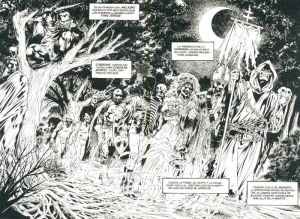The Santa Compaña, or Santa Companha is a procession of the dead or souls in torment wander the path of a parish at midnight.
Etymology
Santa Compaña means Holy Company in Castillan. It is also known under the names of Estadea, Estantiga (estantigua in Spanish, from Latin hostes antiquus, confounding the meaning of "ancient enemy", a euphemism for the Devil, and host, a military troop), Güestia in Asturias, Rolda, As da noite [The Night Ones], Pantalla, Avisóns, Pantaruxada.
Description
A living person carrying a cross and a cauldron of holy water leads the procession followed by all the souls with lit candles, although not always seen, the smell of wax and the breeze which appears when they pass warn of their presence. The person leading the procession can be a man or a woman -- this all depends on whether the patron saint of the parish is male or female. To conclude, the Santa Compaña is an announcer of death, its one mission is to visit the homes where death is due.
The person carrying the cross must never turn around or renounce his duty in leading the Santa Compaña; he can only be freed from his duty if he manages to find another person to carry the cross and the cauldron.
To avoid this obligation the person who sees the Santa Compaña pass by must draw a circle on the ground and enter it, or he can also lie face-down. Other ways to evade Santa Compaña is to tie a black cat in the middle of Santa Compaña and run away from it, or realize diverse symbols with both hands as a horn gesture (extending the index and little fingers and to contract the rest of fingers) or the fig sign (which consists of closing the fist and putting the thumb between the index and middle fingers).
See also
References
- Paredes, Xoan (2000). "Curiosities across the Atlantic: a brief summary of some of the Irish-Galician classical folkloric similarities nowadays. Galician singularities for the Irish" (in English). Dept. of Geography, University College Cork, Ireland. Retrieved on 2008-08-14.
- J. Cuveiro Piñol, Diccionario Gallego, Barcelona, 1876: Compaña: entre o vulgo, creída hoste ou procesión de bruxas que andan de noite alumeadas con osos de mortos, chamando ás portas para que as acompañen, aos que desexan que morran axiña…
- Elisardo Becoña Iglesias, "La Santa Compaña, El Urco y Los Muertos", A Coruña, 1980

